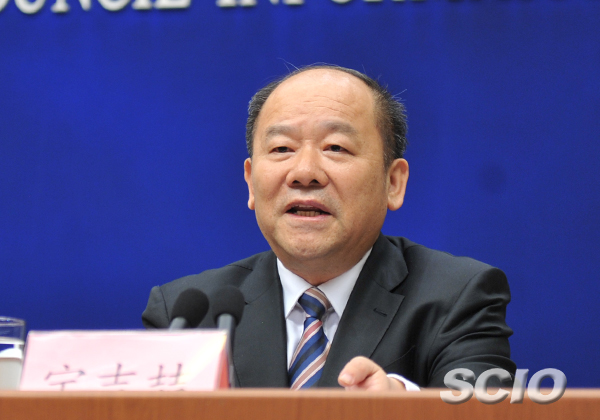China posts 7.2 percent growth over past 5 years
By Guo Yiming
From 2013 to 2016, China's average annual GDP growth was 7.2 percent, higher than the average 2.6 percent growth of the world economy and the average 4 percent growth of developing countries, the National Bureau of Statistics (NBS) announced Tuesday.
|
|
|
Ning Jizhe, director of the National Bureau of Statistics. [Photo by Yuan Shaoda/China SCIO] |
"China's economic performance remained within proper range with further enhanced comprehensive national strength and international influence," NBS Director Ning Jizhe said at a press briefing at the State Council Information Office ahead of the upcoming 19th National Congress of the Communist Party of China.
Over the past five years, China as the world's second largest economy has entered a "new normal" in its economic development. Ning said this was reflected in the country's transition to a "medium-to-high" speed growth economy, its economic structural upgrades, and the accelerating shift from old economic drivers to new ones.
A 7.2 percent average growth in the past five years, combined with growing employment rates and stable prices, puts China at the top amongst the world's major economies, and its total GDP of US$11.2 trillion in 2016 accounted for 14.8 percent of the world economy, said Ning, who also serves as the vice chairman of the National Development and Reform Commission (NDRC).
"From 2013 to 2016, the contribution of China's economy to the world economic growth stood at around 30 percent on average, surpassing the total contribution of the United States, Eurozone and Japan," Ning said.
He added that China's economic structural upgrades can be seen in its rising consumption and domestic demand as well as its dominant service sector.
From 2013 to 2016, the final consumption expenditure contributed to 55 percent of the economic growth annually on average; the value added of the tertiary industry moved to account for over half of the national economy.
In 2016, the expenditures on research and development activities (R&D) reached 1,567.7 billion yuan (US$237.7 billion), up 52.2 percent from 2012, which gave rise to a number of landmark achievements in science and technology such as quantum communication, high-speed railways, manned spaceflight missions, the lunar exploration program, the radio telescope, the large commercial aircraft, the manned deep-sea submersible, and super computers.
Economic progress was made in parallel with stronger efforts in energy saving, environmental protection as well as improved livelihood among the general public.
In 2016, China's energy and water consumption per unit of GDP was cut by 17.9 percent and 25.3 percent compared with 2012; in the same year, the completed afforestation areas were 7.2 million hectares nationwide, up 28.7 percent compared with five years earlier; an additional 5.62 million hectares was under soil erosion control, up by 28.6 percent from 2012.
Last year, the national per capita disposable income was 23,821 yuan (US$3,612.3), an increase of 7,311 yuan (US$1108.7) compared to that of 2012, an annual increase of 7.4 percent on average.
As the largest contributor to the world economic growth, China's economic, political, cultural, social and ecological progress was made against major headwinds in the international economic and political environment as well as domestic challenges, Ning said.
All of the achievements were attributed to the CPC's strong leadership, the country's new development philosophy, the supply-side reform, and the commitment to reform and opening up, he said.
